Unit 2 prokaryotes and identification STUDY THIS FOR FINAL
1/121
Earn XP
Description and Tags
Chpt 8 = Central Dogma of Biology, mutagens, operons and genes
Name | Mastery | Learn | Test | Matching | Spaced |
|---|
No study sessions yet.
122 Terms
Degeneracy
Is why different mRNA combos can equal the same amino acid
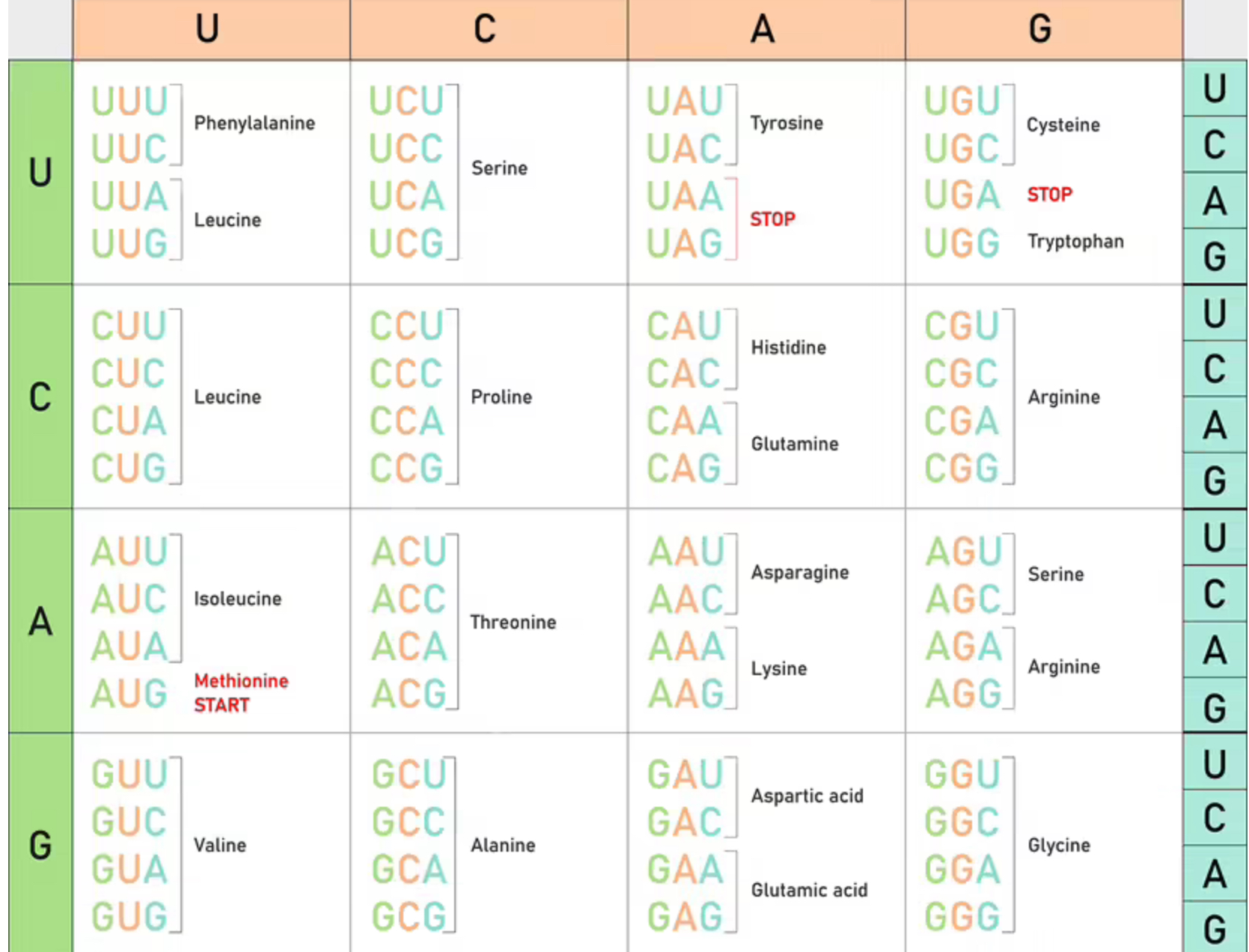
What is required for DNA replication (their are 7 things)
helicase
Primase
DNApolymerase
DNA nucleotides
RNA nucleotides (primers)
Both current DNA strands
Gyrase
topoisomerases
What components are required for transcription (their are 5 things)
RNA nucleotides
RNA polymerase
DNA template strand
Promoter region
Terminator region
What RNA is involved in translation
tRNA(deceivers the proper amino acid to the ribosome), mRNA(is the message that will be translated), and rRNA (restricts certain mRNAs from being translated)
Stem loop
A structure that forms at the end of an mRNA translation
Causes the RNA to hydrogen bond with itself to pull off the DNA template strand
What would increase the concentration of a particular polypeptide in a cell?
An increase in transcription (leads to a more frequent translation)
What direction is the DNA read during transcription?
3’ to 5’
What direction is the mRNA synthesized during transcription?
3’ to 5’
What are the 3 stages of translation?
Initiation ( the finding of the reading frame through AUG codon)
Elongation (the continuation of amino acids bonding to a polypeptide chain
Termination ( when the ribosome hits a stop codon)
What is the start codon
AUG (mRNA) MET (Amino Acid)
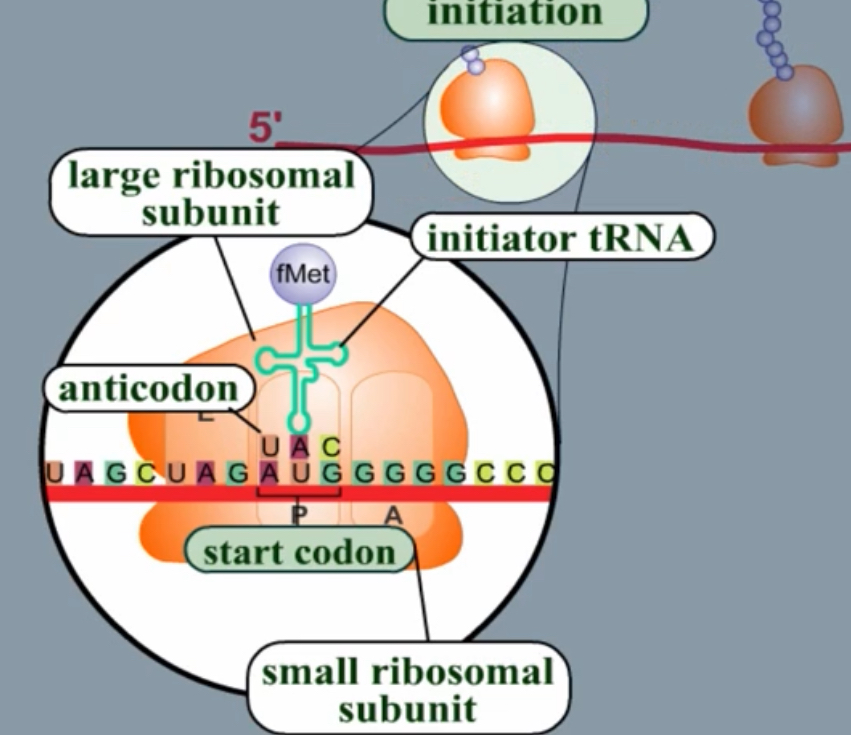
What are each of the sites for a ribosome
A site (Amino Acid site)
P site (polypeptide site or bonding site)
E site (exist site)
During the initiation step of translation, the fMet charged tRNA assembles in which site of the ribosome?
P site
When does tRNA become uncharged during translation?
After the amino acid binds to the polypeptide chain (the P site and E site)
How is translation terminated?
When a protein called a release factor enters and binds to the A site
(Stop codon is hit and calls in the factor)
How do repressors work on a lac operon?
They stop mRNA polymerase from bonding to the operator region of the gene
What is the difference between generalized transduction and specialized
Generalized transduction is initiated during lytic cycle of a virulent bacteriophage; specialized transduction is initiated during the lysogenic cycle of a temperate bacteriophage.
How does an F+ cell differ from an Hfr cell?
Hfr strains have the F plasmid integrated into the chromosome and can give a small part of that chromosome and extras to F - cells.
Which of the following is a characteristic of an F+ cell?
Ability to synthesize sex pili, presence of a fertility factor, and ability to mate with an F- cell
Leading strand being built
3’ 5’ direction (template 5’ 3’)
Lagging strand direction
5’ 3’ (template is 3’ 5’)
Topoisomerease and gyrase
Helps unwind DNA before it reaches Helicase
Specific Transduction
takes a VERY SPECIFIC set fo DNA from the host and transfers it into another cell
General Transduction
takes any DNA it can take and transferring it to a bacteria
Conjugation
Creates a bridge between both cells where one sends DNA to another
Cells must have an F plasmid for this to be initiated
The bridge to the cell is made by the pilus reaching out to the other cell
(Think hfr and F- cell interactions)
Tranfromation
When a cell runs into some DNA that it is comparable with
Needs to take DNA from the outside, that could be hindered by DNAases
(Think Griffith experiment and virulent DNA changing non-virulent cells)
Auxotrophic
lacks the ability to make essential molecules, nutrients need to be found in the environment or else they will die
Prototrophic
Can make their own essential molecules, their genome has the enzymes into the essential nutrient ( some cells can create certain nutreient wile they need to find others)
Mutagens
external stressors such radiation, and chemical agents (think UV light for radiation, bromouracil in the case of chemical)
What causes a thymine dimer? Is it repaiarable? By what?
UV light, In most cases, yes, it is repaired via nucleotide excision repair (takes damaged nuclueotides and extras, then resynthesizes the cut out part)
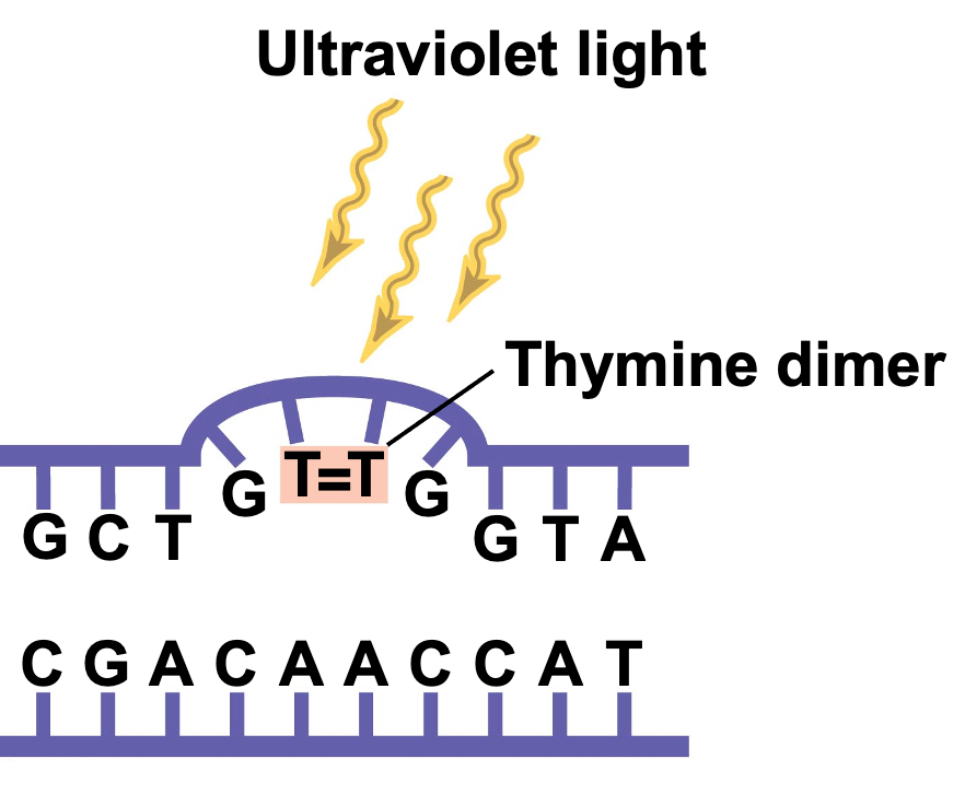
Frame shift mutagens
chemical in nature, these mutagens can embed themselves into DNA groves and case DNA distortion
DNA replication stops
DNApolymerase makes a mistake and adds additional bases to the daughter cells (insertions)
DNApolymerase skips a base that the mutagen is in between (deletion)
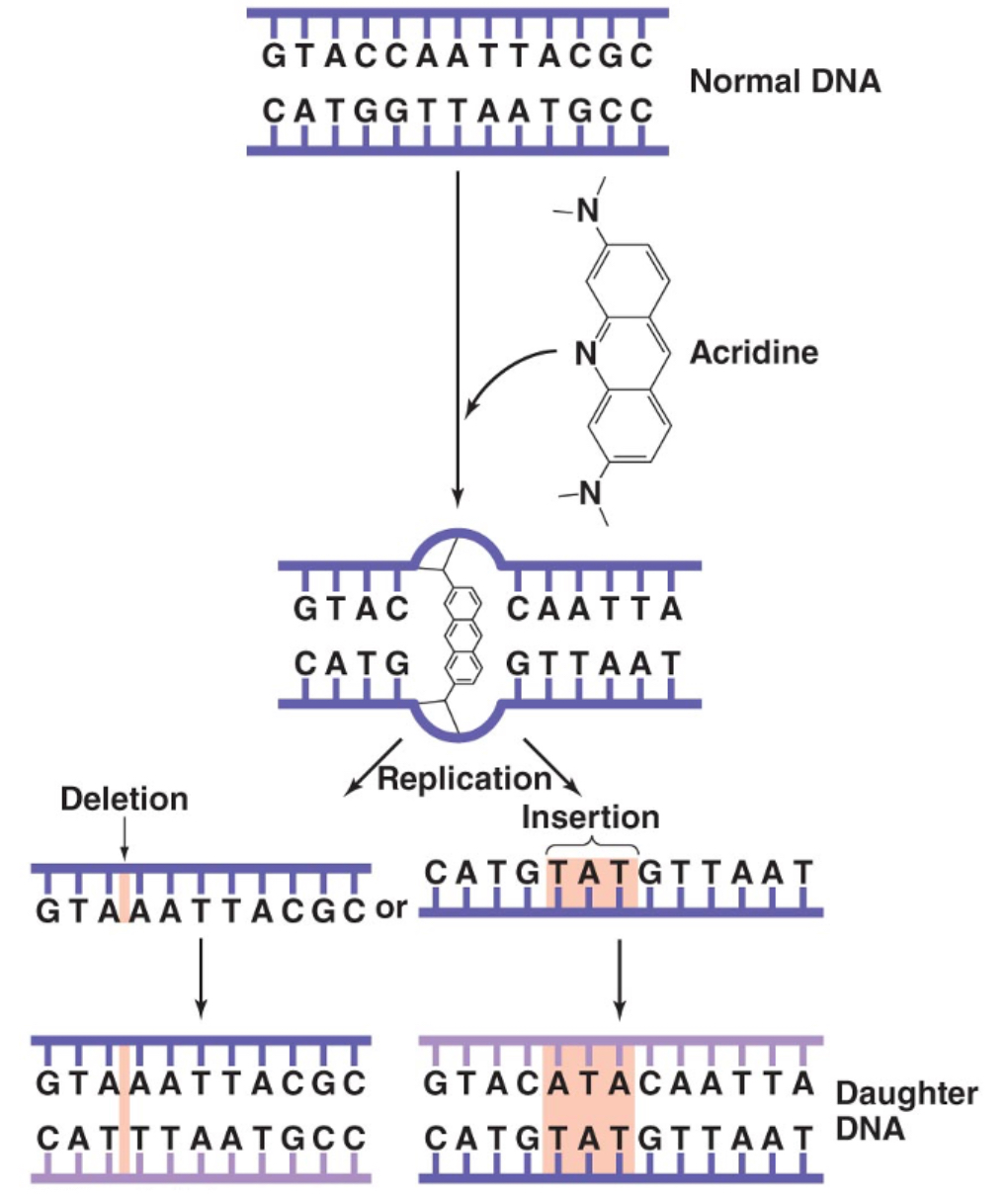
Ames Test
A test that looks for a suspected mutagens and possible carcinogens. It starts with 2 tubes, one with the mutagen and one control (both have liver enzymes to activate mutagen) that are added to a plate that has histidine, an amino acid that the cell cannot break down, if the plates shows growth then the cell was mutated to be able to break down the histidine and the suspected substance is a mutagen
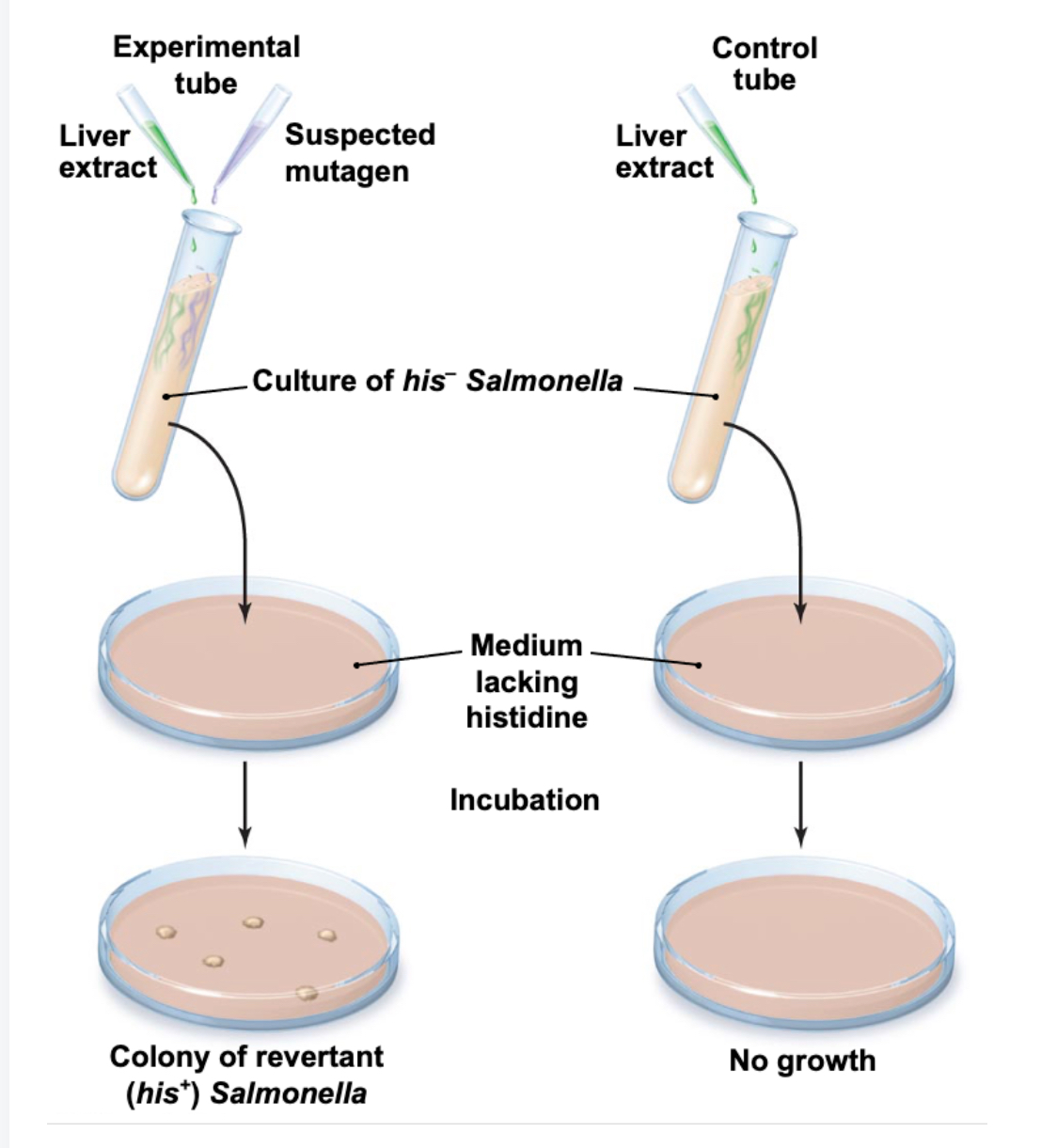
Enzymes that are produced only when needed in the cell are called
Inducible enzymes
Positive (direct) selection
Positive (direct) selection involves the detection of mutant cells by rejection of the unmutated parent cells.
It enables detection of a rare mutant from a population containing an extremely large number of bacteria.
The mutant will grow on the selective medium, so there is no need for replica plating.
Nucleotide Analog
is a type of mutagen that is similar to it’s nucleotide counterpart in structure but not base pairing, meaning that when DNA replication is being done and the analog taken, it will not base pair with it’s complement.
Give 3 different pieces of an operon and tell me what they do
Promoter (lets the RNApolymerase link to the DNA strand, Operator (the part that is repressed and stops the polymerase unless a condition is met), and Structural genes ( the genes that create stuff)
Genes whose products are produced constantly are known as
Constructive genes (not regulated)
Repressible genes
Genes that are turned off (needs to have a condition satisfied to be turned back on)
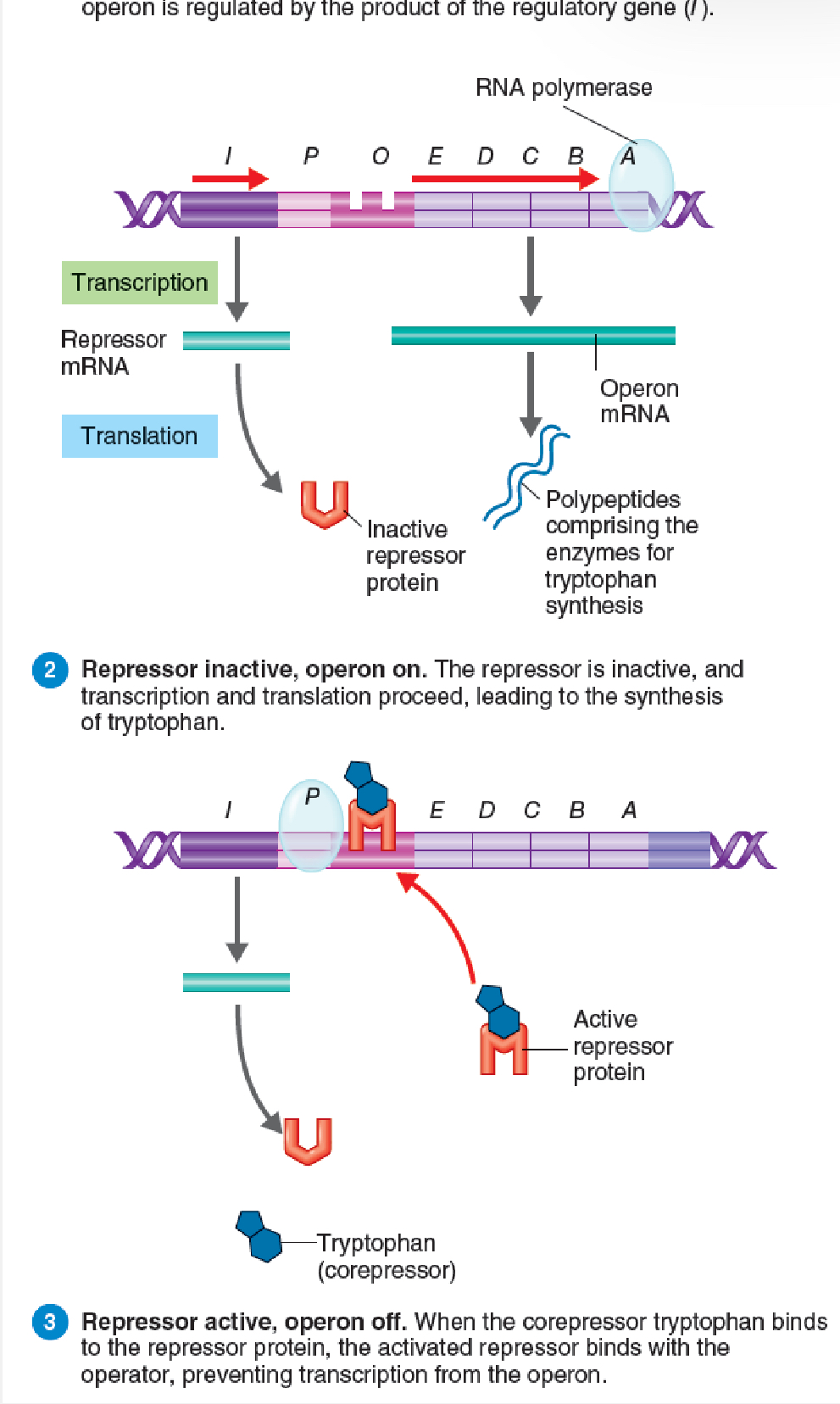
Inducible genes
Genes that are turned on (their products are needed by the cell)
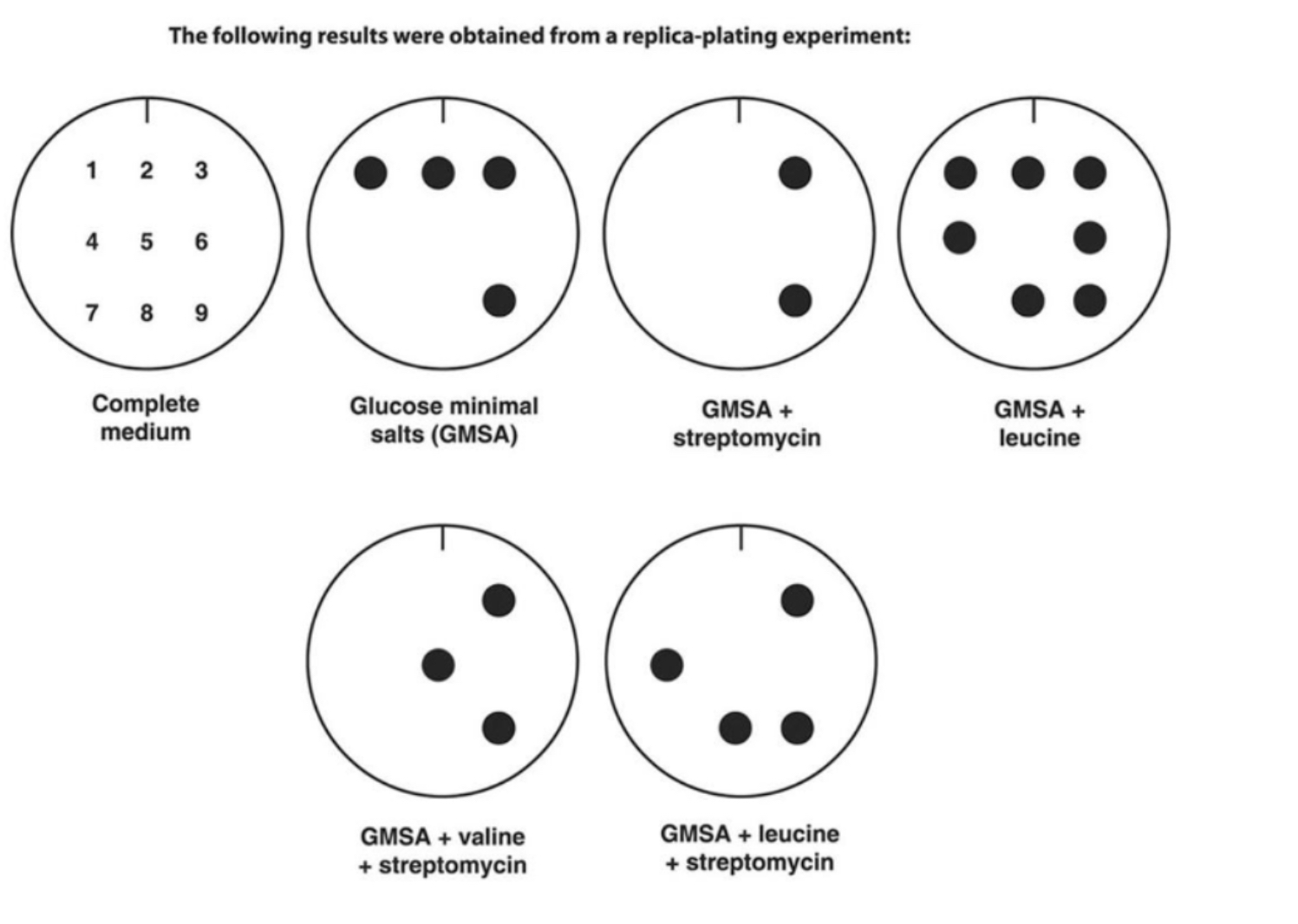
Which of these are auxotrophic?
1, 2, 3, and 9
Snapping division
when a cell elongates after cell division and ultimately begins to snap once both sides get to big
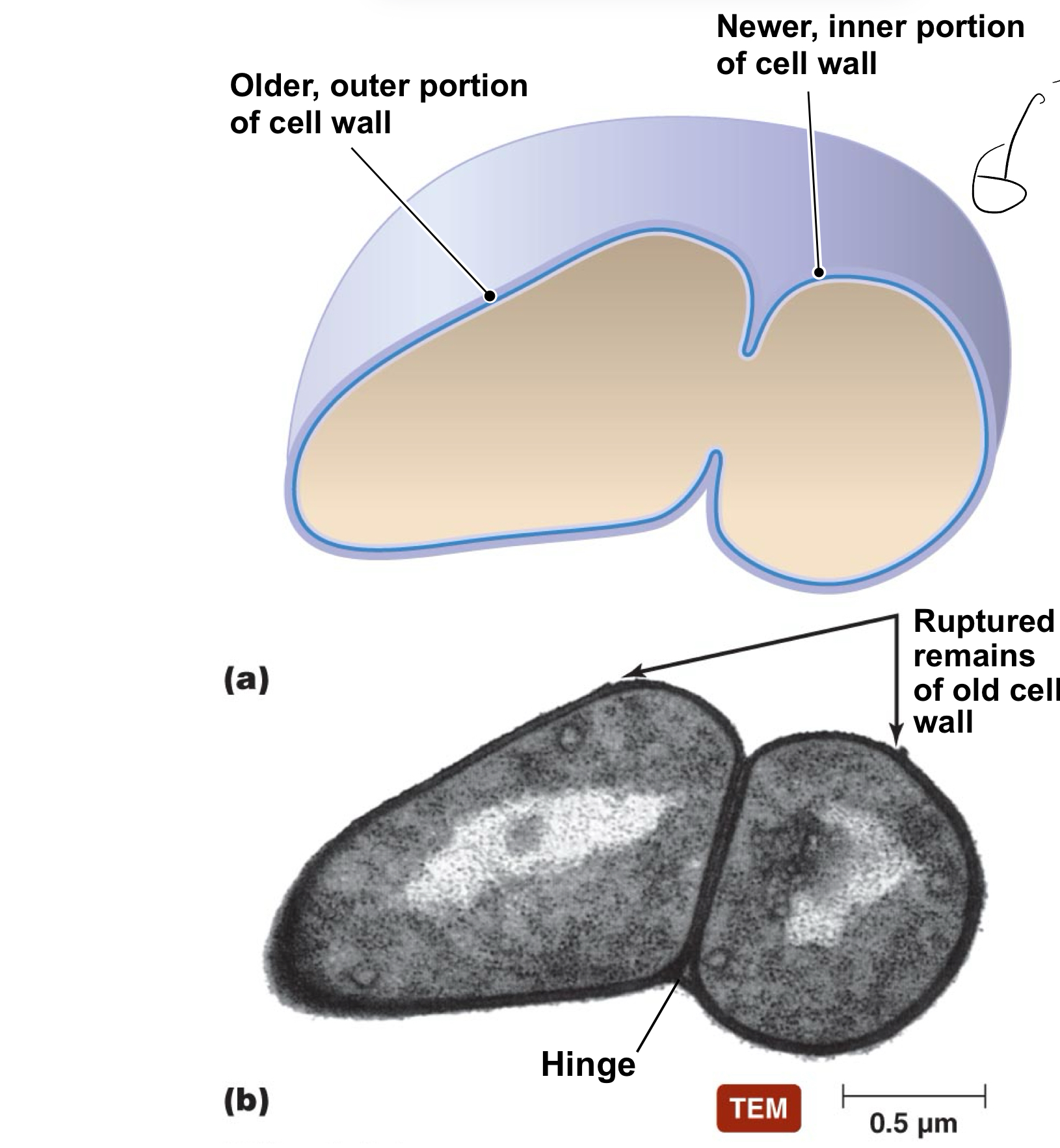
Reproductive spores
Think dandelion in for how this works, a cell builds up a ton of small sporeium and then bursts. Then these small sporeiums then go some where far to recreate a similar structure to their parents
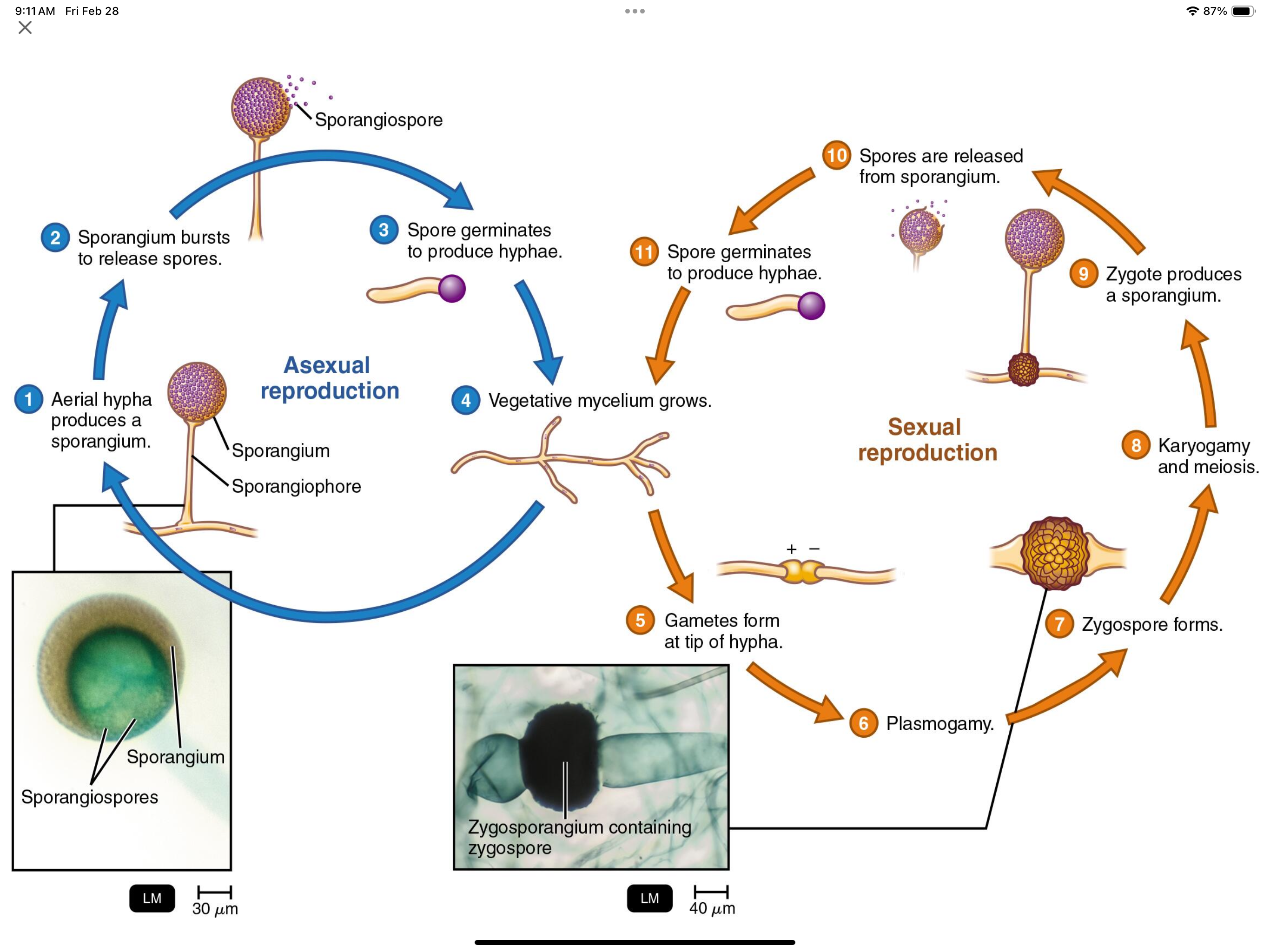
Budding
Think of a cactus growing it’s’ arms, it allows for a young bud to form after DNA synthesis then separates after a certain amount of time

Viviparity
think similar to how a bacteriophage works but instead of lysis due to phages, it is because of offspring that the cell has inside it

Arhcaea
Are prokaryotic cells
Lack peptidoglycan in cell walls
Cytoplasmic membrane lipids are branched or ringform hydricarbon chains (helps them survive in low pH and high temp environments)
Use AUG like eukaryotic cells
Crenarchaeota
Methanogens
Largest group of archaea
Makes most of the methane gas
Lives in colons of animals
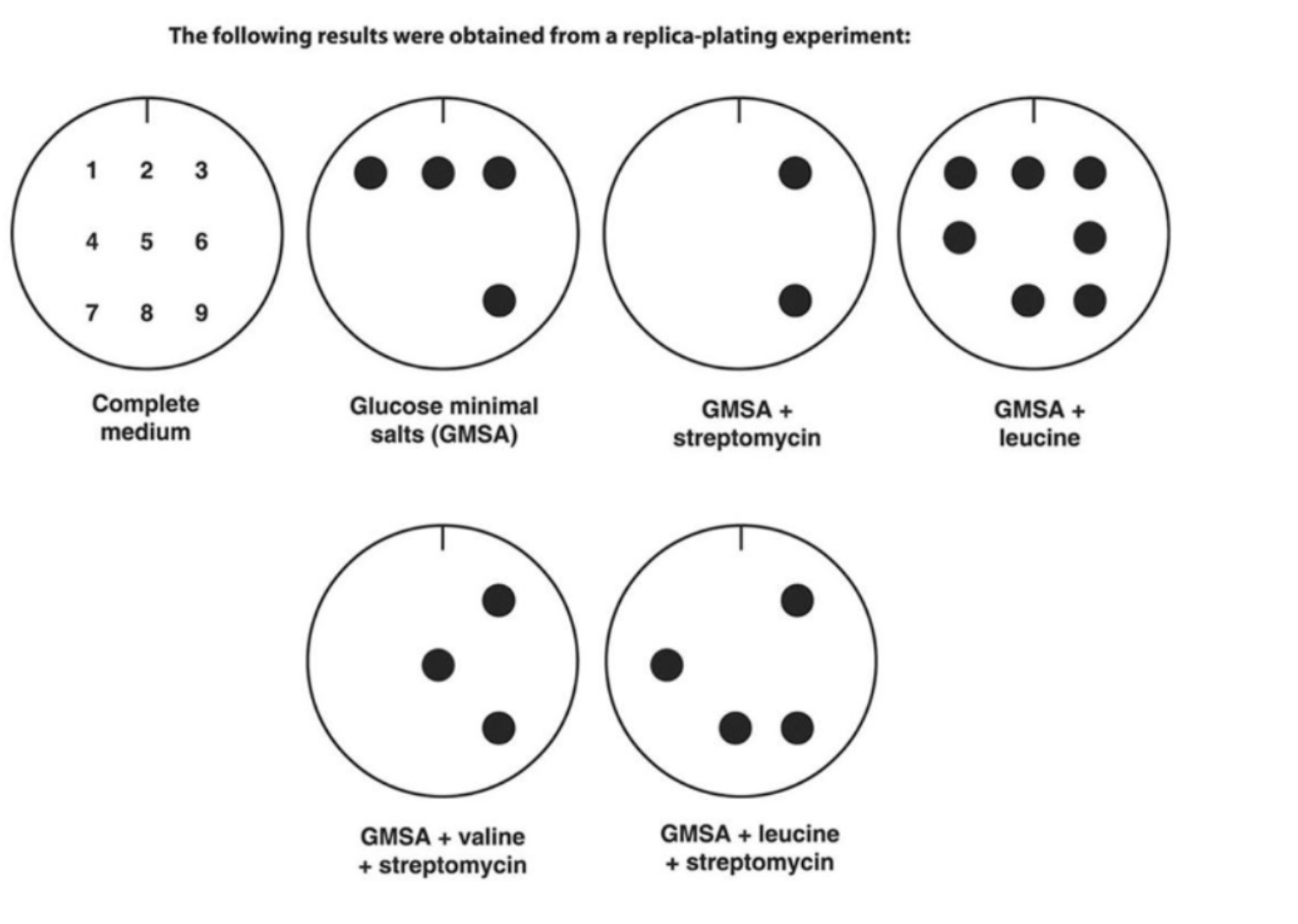
Which of these are prototrophs
only 5 (is on plate with both streptomycin and valine
What does low G + C gram positive mean?
It means that Guanine and cytosine are below 50%
They have similar 16S rRNA sequences
Are rod-shaped, obligate anaerobes
Clostriadia
Rod-shaped, obligate anaerobes
Produce toxins that cause disease in human
Has endospores that survive in harsh conditions
Are low G + C gram-positive
Mycoplasma
Facultative or obligate anaerobes
Lack cell walls • Smallest free-living cells
Colonize mucous membranes of the respiratory and urinary tracts of animals
Are low G + C gram-positive
Bacillus
Endospore-forming aerobes and facultative anaerobes
Many common in soil
Listeria
low G + C gram-positive
Contaminates milk and meat products
Capable of reproducing under refrigeration
Survives inside phagocytic white blood cells
Rarely causes disease in adults (can kill fetus in preg women)
Lactobacillus
Grows in the human mouth, stomach, intestinal tract, and vagina
Rarely causes disease
Inhibits the growth of pathogens within the body
Used in the production of various foods
low G + C bacilli
Streptococcus and Enterococcus
low G + C bacilli and cocci
Cause numerous diseases in humans
Various strains of multi-drug-resistant streptococci
Staphylococcus
low G + C bacilli and cocci
One of the most common inhabitants of humans
Produces toxins and enzymes that contribute to diseases
High G + C Gram positive Bacteria
cells that have more G and C than other nucleotides (A and T)
Corynebacterium
High G + C Gram-Positive Bacteria
Pleomorphic aerobes and facultative anaerobes
Produces metachromatic granules
Has vacancies for it
Mycobacterium
High G + C Gram-Positive Bacteria
Has waxy cell walls that let it survive
Aerobic rods that sometimes form filaments
Slow growth, partly due to mycolic acid in its cell walls
Some species are pathogens of animals and humans
Gives lepracy and turbercuosis
Actinomycetes
High G + C Gram-Positive Bacteria
Form branching filaments resembling fungi
Cause disease primarily in immunocompromised patients
Important genera include Actinomyces, Nocardia, Streptomyces
Gram-Negative Proteobacteria
Largest and most diverse group of bacteria
Five classes of proteobacteria
Alphaproteobecteria
Betaproteobacteria
Deltaproteobacteria
Gammaproteobacteria
Epsilonproteobacteria
Alphaproteobacteria
Often capable of growing at low nutrient levels
Some species have extensions called prosthecae
Used for attachment to surfaces and nutrient absorption
Nitrogen fixers
Two genera important to agriculture Azospirillum( helps with nutrient intake), Rhizobium (makes NH4)
Grow in association with the roots of plants
Are pathogenic to humans
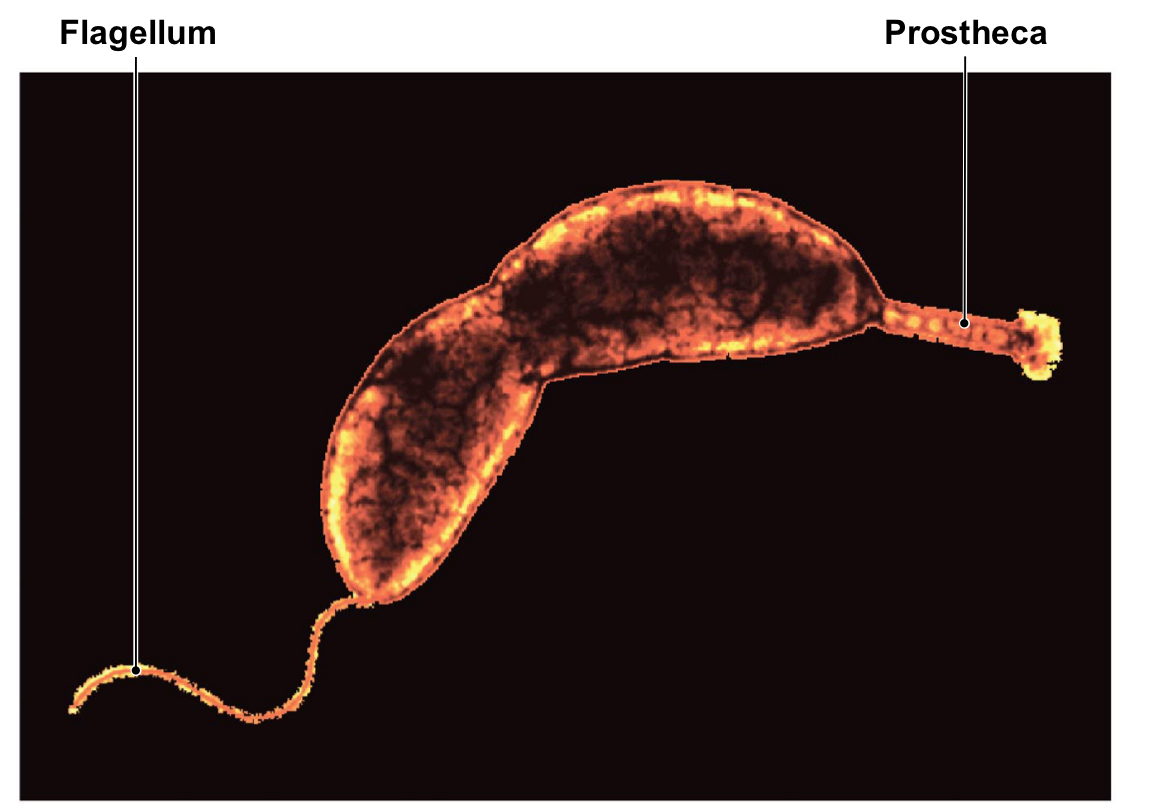
Betaproteobacteria
Are gram negative
Are pathogenic to humans
Neisseria
• Inhabits mucous membranes of mammals • Causes numerous diseases
Pathogenic betaproteobacteria
Bordetella
Causes pertussis
Pathogenic betaproteobacteria
Burkholderia
Colonizes moist environmental surfaces and
respiratory passages of cystic fibrosis patients
Pathogenic betaproteobacteria
Thiobacillus
Recycles sulfur in the environment
Zoogloea
Form flocs that assist in the treatment of sewage
non sheath forming
Non sulfur oxidizing Bacteria
Sphaerotilus
Flocs impede flow of waste in treatment plants
Gammaproteobacteria
• Largest and most diverse class of proteobacteria
• Divided into subgroups
• Purple sulfur bacteria
• Intracellular pathogens
• Methane oxidizers
• Glycolytic facultative anaerobes
• Pseudomonads
Are pathogenic to humans
Gammaproteobacteria
Purple sulfur bacteria
• Obligate anaerobes
• Oxidize hydrogen sulfide to sulfur
• Found in sulfur-rich zones in lakes, bogs, and oceans
A single mRNA may have several ribosomes attached.
True, they can!
Assume a cell is grown in a culture medium containing radioactively labeled thymidine. After three cell divisions, what percentage of the cells would contain the radioactive label?
Cells must replicate their DNA before dividing. As DNA is replicated, radioactively labeled thymidine will be incorporated into the new DNA, thus 100% would contain the radioactive label.
When the antibiotic chloramphenicol binds to the 50S portion of the ribosome, the effect is to _____
prevent the ribosome from moving along the mRNA strand
Which of these statements correctly describe RNA processing in eukaryotic cells?
mRNA is processed before is leaves the nucleus
Introns are removed and the remaining exons are spliced together.
Processing involves snRNPs.
What gene would be the most likely to yield a recombinant cell after mating? (Cells)
R factors—antibiotic-resistance genes are plasmids that have significant medical importance. R factors carry genes that confer upon their host cell resistance to antibiotics, heavy metals, or cellular toxins.
How do Hfr cells work and what do they pass on
In E. coli, Hfr cells can pass main chromosome genes to a recipient cell. In some cells carrying F factors, the factor integrates into the chromosome, converting the F+ cell to an Hfr cell (high frequency of recombination). When conjugation occurs between an Hfr cell and an F- cell, the Hfr cell’s chromosome (with its integrated F factor) replicates, and a parental strand of the chromosome is transferred to the recipient cell.
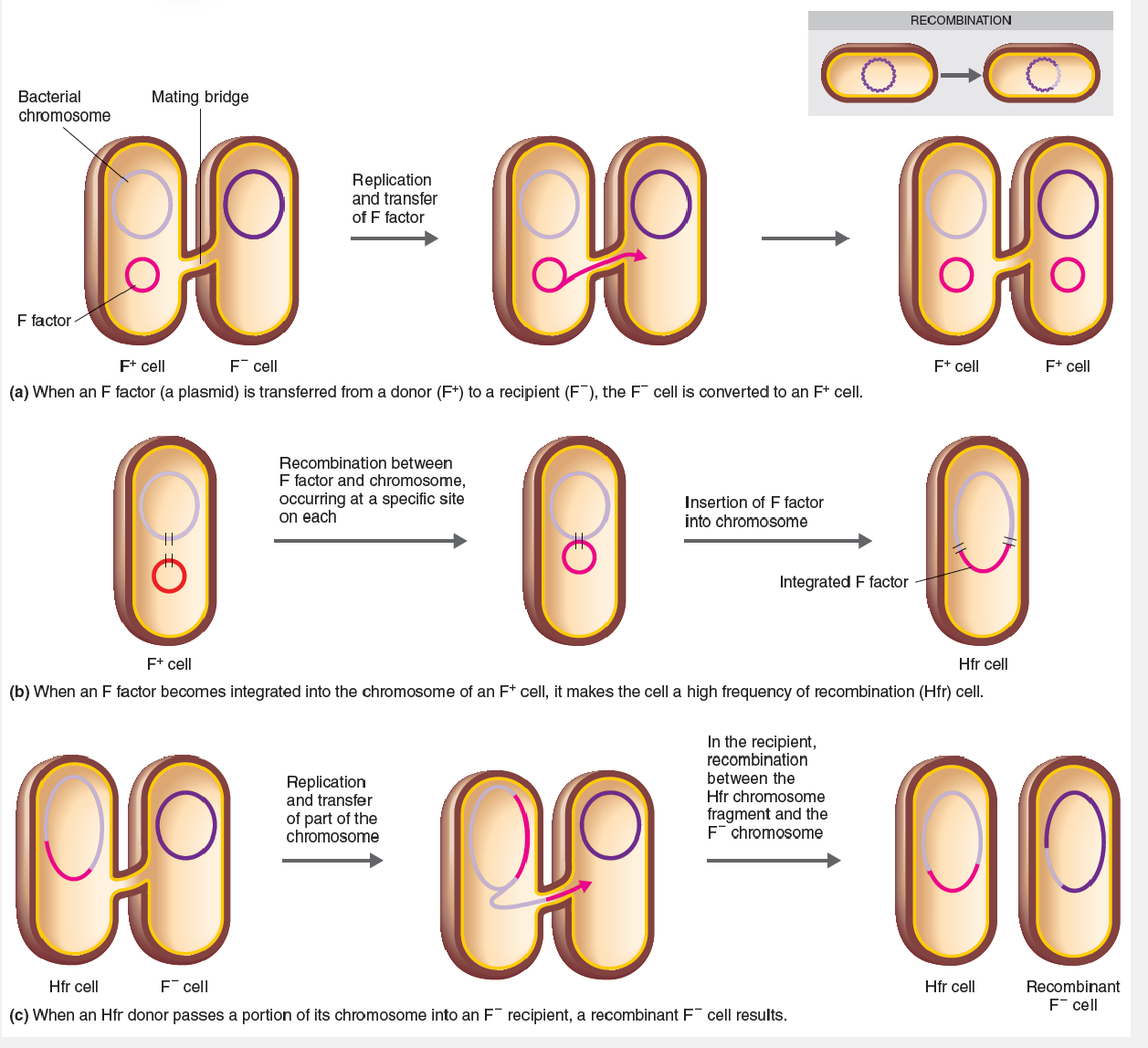
Example of specialized transduction
In specialized transduction, only certain bacterial genes are transferred. In one type of specialized transduction, the phage codes for certain toxins produced by their bacterial hosts, such as diphtheria toxin for Corynebacterium diphtheria, erythrogenic toxin for Streptococcus pyogenes, and Shiga toxin for E. coli O157:H7.
Bacillus
Are gram negative rods
Form endospores
Chlamydias
• Grow intracellularly in mammals, birds, and some invertebrates
• Some are smaller than viruses
• Most common sexually transmitted bacteria in the United States
Gram negative
Uses an elementery body as an infective agent to get to other cells
Spirochetes
• Motile bacteria that move in a corkscrew motion (also looks like it as well)
• Have diverse metabolism and habitats
• Treponema and Borrelia both cause disease in humans
ALL HAVE AXIAL FILAMENTS
Gram negative
Bacteroides
Inhabits digestive tracts of humans and animals
Some species cause infections
Cytophaga
• Aquatic, gliding bacteria
• Important in the degradation of raw sewage
Rickettsias
obligate intercellular parasites
Are alpha-proteobacteria
Induce phagocytosis so that it can get into host cell
Do binary fission in the host’s cytoplasm
Gram Negative Bacillus (or coccobacillus in some cases)
Transmitted by insects and ticks
Cause rashes on humans
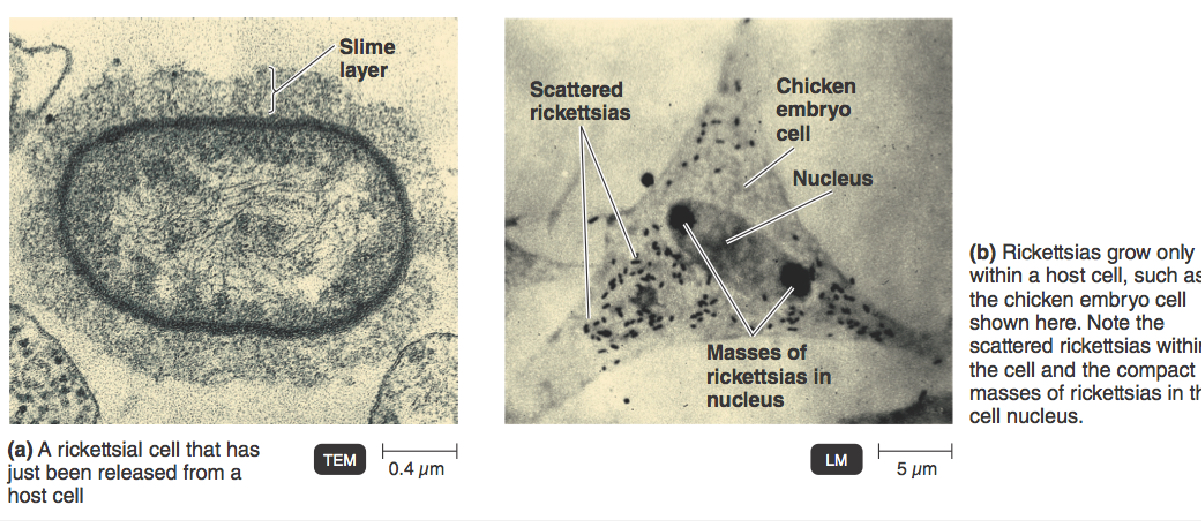
Pseudomonas
Aerobic gram negative bacillus
Can metabolize a wide variety of substrates (VERY COMMON IN THE SOIL)
Have lophotirchus flagella (motile)
Is a Gammaprotebacteria
Erwinia
Plant pathogens (cause soft-rot diseases)
Creates enzymes that break down pectin (plant cell walls)
Gram negative
Gammaproteobacteria
Anaerobes
Legionella
Gammaproteobacteria
Causes pneumonia
Don’t normally grow in a lab setting in media.
Found in warm water supply liens and air cooling towers (in AC units)
Can reproduce within aquatic amebrae making it hade to get rid of them in water systems
Burkholderia
Grows on unusual carbon sources and some antiseptics
Capable of degrading more than 100 different organic molecules
Can actually grow in disinfectants!!!!!!!
Gives people cystic fibrosis
Enterics
Are a class of gram-negative facultative anaerobes that are found in the intestines of animals
Member in the order of Enterobacteriales
Usually active fermenters of glucose and carbs (they are anaerobic)
Mycoplasma
are very small bacteria
Has no cell wall (are related to gram positive bacteria tho)
They produce filaments that resemble fungi
Highly pleomorphic (can change shape and structure)
Need an acid fast stain to be seen
What are some bacteria that are found in foodborne illness?
Salmonella
Shigella
Staphylococcus
Campylobacter
Pelagibacter
free living bacteria
Very small cells
Has a small genome
One of the most abundant microorganisms in the marine environment
Borrelia
is a spirochete (has no filaments)
Deltaproteobacteria
have some bacteria that are predators to other bacteria
Important to the sulfur cycle
Are pathogenic to humans
Cyanobacteria
Include both anaerobic and aerobic cells
Also capable of chemoheterotrophic growth
Carry out photosynthesis in the same way that plants do
Non sulfur cells use organic compounds as the source of electrons for reduction of CO2
have gliding motility
Differnet to alge because they are prokaryotes (alge is eukaryotic)
Pseudomnadota
bacteria that contains majority gram negative chemoheterotrophic bacteria
What are some cells that can fix nitrogen?
Rhizobium, Azotobacter, Azospirillum, and some cyanobacteria
They do it by getting nitrogen form the air and turn it into ammonium that is then used by other organisms in the environment
(Important to agriculture)
Rhizobium
Help with plants by forming nodules in plant roots that allow for nitrogen fixation
Known as rhizobia
Lactobacillales
Don’t perform aerobic or anaerobic resperation
Use lactic acid fermentation to survive
There fermentation makes Yogurt, buttermilk and sauerkraut
Streptomyces
best kneeing for helping with the production of many antibiotics
A soil microbe, causes little diseases
Escherichia
Cells that live in your Colin,
Gammaproteobacteria
Spreads through food and water